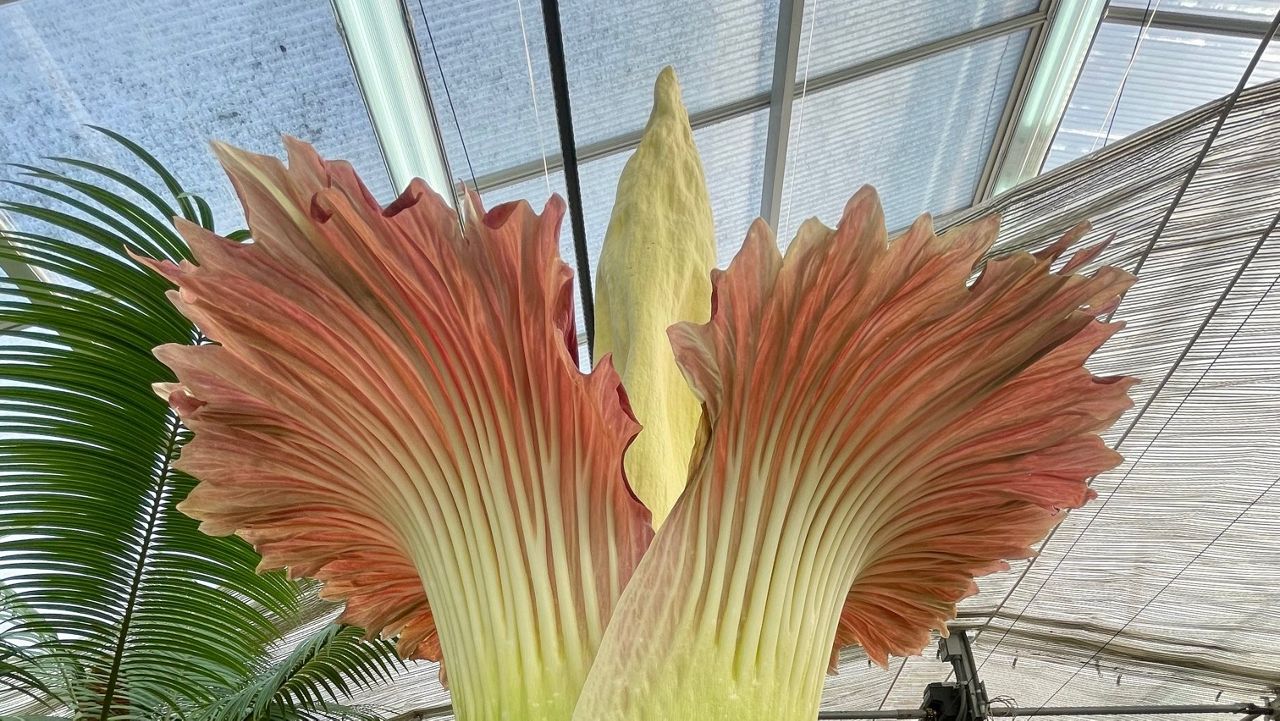LONG BEACH, Calif. — Phil isn't dead. He's just raising a stink.
Researchers at California State University, Long Beach’s tropical greenhouse watched with rapt attention as the school’s titan arum — or "corpse flower" — bloomed for the second time in three years last week, treating researchers to a very unpleasant but fascinating aroma.
What You Need To Know
- California State University, Long Beach's titan arum — or "corpse flower" — bloomed for the second time in three years last week
- The plant at CSULB is known as "Phil," named for Dr. Philip Baker, a CSULB professor emeritus and former instructor in plant taxonomy
- Now about 14 years old, Phil the plant came to CSULB as a seedling 13 years ago and bloomed most recently in 2019
- Corpse flowers generally only bloom every seven to 10 years
The plant at CSULB is known as "Phil" — named for Dr. Philip Baker, a CSULB professor emeritus and former instructor in plant taxonomy (now known as plant systematics on campus). Now about 14 years old, Phil the plant came to CSULB as a seedling 13 years ago and bloomed most recently in 2019 at the same time as another corpse plant known as Laura. The fact that Phil blossomed again — so recently after his last bloom — is a big deal.
To mark the occasion, CSULB’s College of Natural Sciences and Mathematics set up a “greenhouse cam” YouTube live stream, which started running days before the flower’s full blossoming on June 14 and was still going despite the flower’s closure on June 16.
Phil’s blooming period lasted 36 hours, according to CSULB social media accounts.
Corpse flowers generally only bloom every seven to 10 years. But thanks to the conditions in the school’s tropical greenhouse (including a humid environment and nutritious fertilizer), Phil rose again this year. A major part of that is Brian Thorson's work, which babies the plants, he told CSULB. He is also not afraid to experiment.
"I love to grow these really rare, hard to grow plants and figure out how to do it successfully and even push them to give me more," said Brian Thorson, a CSULB botanical curator and botany technician.
The corpse flower's pungent odor is actually key to the plant’s survival. Its main pollinators are carrion beetles and flesh flies: Critters that, as their names imply, prefer to eat and lay eggs in rotting flesh. To attract them, the corpse flower heats up to between 80 and 95 degrees Fahrenheit, its color changes to a deep purple and it emits that rotting odor.
This year, however, Thorson observed that something was different: Rather than its typically fishy scent, Phil smelled like something closer to a spoiled diaper. What changed?
"You can only speculate because millions of years of evolution went into the development of all of this," Thorson said. "Let's say it's a warmer season. Then, different types of insects could be more abundant than if there were a cooler blooming season. It could be that this scent was tailor-made for what a particular type of insect might be more prevalent in the environment to pollinate it."
But since the college's greenhouse doesn't have pollinators (like those carrion beetles or flesh flies) present, Phil's caretakers are tasked with pollinating the plant by hand — which includes carving a window-like opening into the plant to reach its blooming flowers.
“If our attempt to self-pollinate him is successful, then he will not go into full dormancy until his seeds have developed and ripened,” read a caption on CSULB’s Science & Math Instagram page.
But researchers won't know whether their attempt was successful for another few weeks, Thorson said. As it stands, Phil has already started wilting. The plant's spadix — the portion that, in photos, looks like the nose cone of a rocket — has flopped over.
It looks a bit unpleasant, admitted Thorson, who also agreed that so much of the plant is unpleasant or uncomfortable to some degree. That, he said, ties into a lot of the popular fascination with the plant.
"I just love it because it's remarkable," he said. "Its adaptations — and this is only one of billions of plant adaptations that result in reproductive strategies in plants that are equally as fascinating, regardless of how they smell or what they look like. It's amazing that they even exist."
